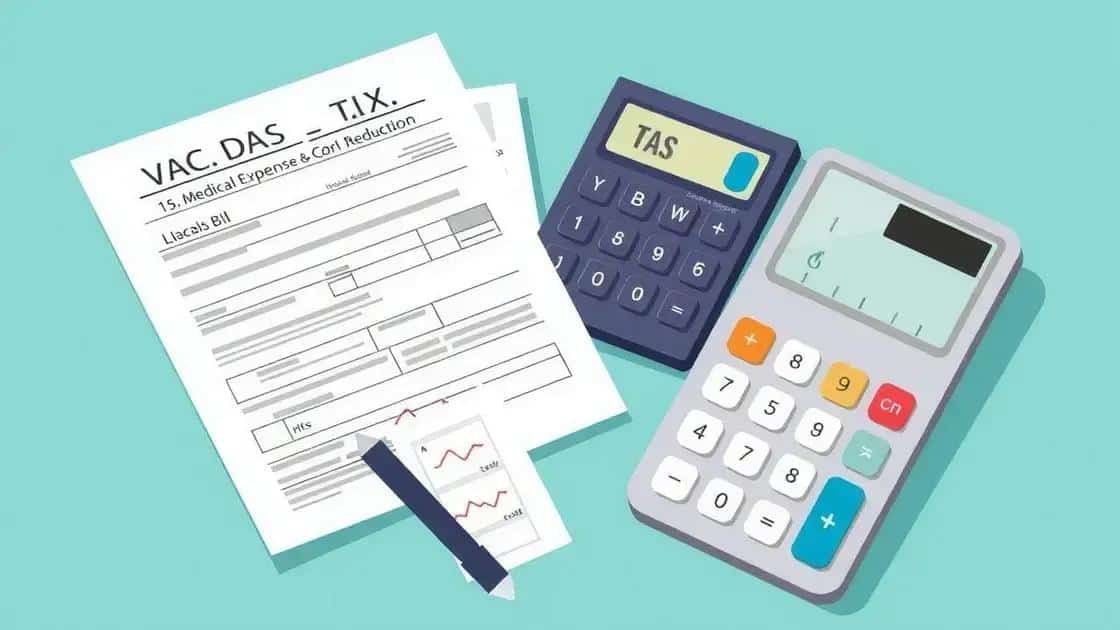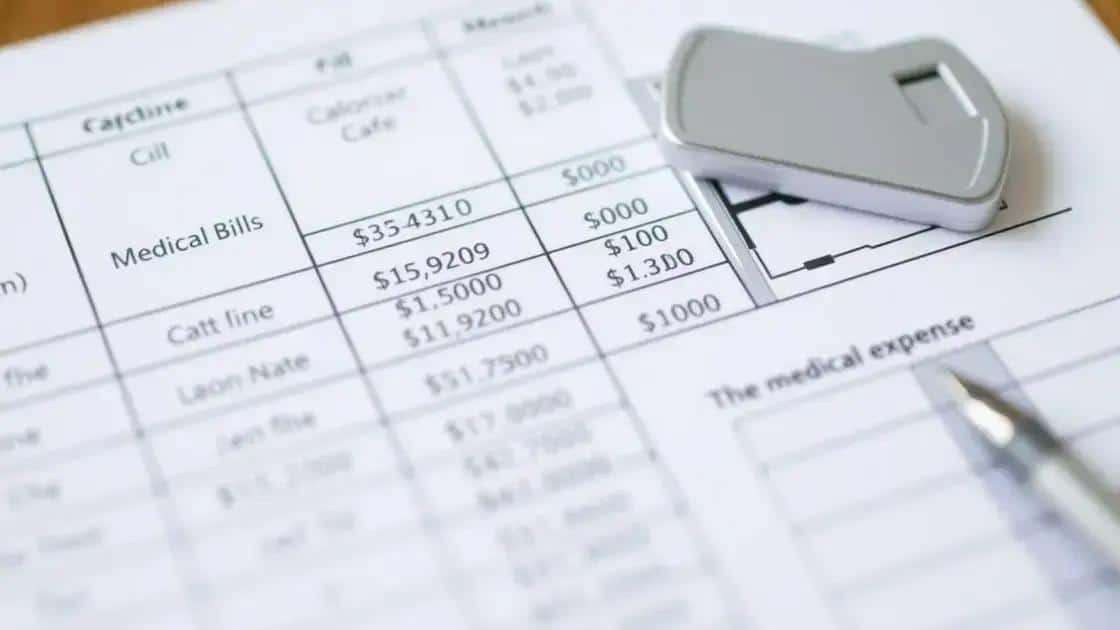Medical expense tax deductions you need to know

Medical expense tax deductions allow taxpayers to deduct qualified medical costs, such as doctor visits, prescriptions, and hospital stays, that exceed a specified percentage of their adjusted gross income to reduce their taxable income.
Medical expense tax deductions might be a game changer for your tax filings. Have you considered how these deductions could ease your financial burden? Let’s explore the essentials in this article.
Understanding medical expense tax deductions
Understanding medical expense tax deductions is essential for anyone who incurs medical costs throughout the year. These deductions can significantly reduce your taxable income. But how do you know what qualifies and how to take advantage of them?
What qualifies as a medical expense?
To effectively use your medical expense tax deductions, you must know what expenses qualify. Generally, medical expenses include payments you make for healthcare services, such as:
- Doctor visits and consultations
- Prescription medications
- Hospital stays and surgeries
- Medical equipment, like wheelchairs or crutches
Additionally, transportation costs incurred while seeking medical care can also be deductible. For instance, mileage driven for visits to your doctor is a valid expense. It is crucial to keep detailed records and receipts for all these expenses, as they will be needed when filing your taxes.
How to calculate your deductions
Calculating your deductions can seem daunting, but it doesn’t have to be. Start by adding up all your qualified medical expenses for the year. Then, compare this total to your adjusted gross income (AGI). You can only deduct medical expenses that exceed a specific percentage of your AGI. Currently, the threshold is 7.5% for most taxpayers. For example, if your AGI is $50,000, you can only deduct medical expenses exceeding $3,750.
Another important consideration is whether to itemize your deductions or take the standard deduction. Taxpayers with significant medical expenses often benefit from itemizing, particularly if their total deductions are higher than the standard deduction.
Additionally, if you’re self-employed, you may be able to take even more advantage of these deductions through a Health Savings Account (HSA) or Flexible Spending Account (FSA), which allow you to set aside pre-tax dollars for healthcare costs.
Common mistakes to avoid while filing
While filing for medical expense tax deductions, there are several common pitfalls to watch out for:
- Neglecting to keep accurate records of medical expenses
- Not knowing which expenses are eligible for deductions
- Confusing insurance reimbursements with out-of-pocket expenses
- Failing to meet the adjusted gross income threshold
Understanding these common mistakes can help ensure you don’t miss out on valuable deductions. Always consult a tax professional if you have questions or concerns regarding your tax filings.
What qualifies as a medical expense?

When considering what qualifies as a medical expense, it’s important to recognize that not all costs related to health care are deductible. Medical expenses are generally any costs incurred to diagnose, treat, mitigate, or prevent disease. Understanding what counts can help you maximize your tax deductions.
Common qualifying expenses
Many common expenses qualify. These can include:
- Doctor visits: Visits to any licensed medical professional, including physicians and specialists.
- Hospital care: Costs for in-patient treatment, surgery, and other hospital services.
- Prescriptions: Any medication prescribed by a medical professional.
- Medical equipment: Purchases of items like wheelchairs, crutches, and blood sugar monitors.
In addition to these, preventive care services like vaccinations and screenings are also considered qualified expenses. If you visit a clinic for routine tests, those costs can add up, contributing to your deductions.
Transportation and travel costs
You might be surprised to know that transportation costs related to medical care may also qualify. This includes mileage driven to visit a doctor or the costs associated with public transportation to reach medical appointments. Keeping a log of your travel can help you claim these deductions.
Moreover, lodging expenses during long treatments can qualify if you are required to stay overnight and it’s not convenient to travel back home. Knowing all the elements that qualify helps ensure you’re not leaving money on the table during tax season.
Excluded expenses
However, not all costs count as medical expenses. You should be aware of excluded items, such as:
- Cosmetic procedures without a medical necessity
- Health club fees or gym memberships
- Elective surgeries
- Insurance premiums, unless they are part of a qualified plan
It’s vital to keep thorough documentation of any expenses you plan to deduct. Always refer to the IRS guidelines for the most up-to-date information about what qualifies as a medical expense to avoid any surprises when filing your taxes.
How to calculate your deductions
Calculating your deductions for medical expenses can seem challenging, but it doesn’t have to be. Understanding the steps involved will help you maximize your tax benefits. The first step is to gather all your relevant medical expenses for the year.
Gathering your expenses
Your total of qualified medical expenses includes a wide range of costs. Start by reviewing bills from doctors, hospitals, and pharmacies. Don’t forget to include any mileage traveled for medical appointments and any insurance premiums you have paid if they qualify.
- Doctor bills: All bills from your healthcare providers increase your total.
- Prescription costs: Keep receipts for medications throughout the year.
- Transport expenses: Calculate how far you traveled for appointments.
- Equipment purchases: Track spending on any necessary medical supplies.
After collecting these items, add them up to find your total qualified medical expenses.
Understanding the Adjusted Gross Income (AGI) threshold
Once you have your total, it’s important to determine your adjusted gross income (AGI). The IRS states that you can only deduct medical expenses that exceed a certain percentage of your AGI. As of now, this amount is 7.5%. For instance, if your AGI is $60,000, your medical expenses must exceed $4,500 to qualify for a deduction.
To calculate this, take your AGI and multiply it by 0.075. If your total medical expenses exceed this amount, the difference is what you can deduct on your tax return. For example, if your medical expenses total $5,000, you could deduct $500.
Choosing between itemized deductions and standard deduction
Deciding whether to itemize your deductions or take the standard deduction is another crucial step. If your total itemized deductions, including medical expenses, exceed the standard deduction amount, itemizing is usually the better choice.
For instance, if you are single, the standard deduction for the tax year may be around $12,400. If your itemized deductions add up to $15,000, itemizing will save you more on your tax bill.
Taking a careful approach to calculate your deductions will help ensure you do not miss out on any benefits. Make sure to keep a record of everything and check with a tax professional if you need further guidance.
Common mistakes to avoid while filing

When it comes to filing your taxes for medical expense tax deductions, avoiding common mistakes can save you a lot of time and money. Many taxpayers miss out on valuable deductions simply due to oversight or misunderstanding of the process.
Not keeping accurate records
One of the most significant mistakes is failing to maintain organized records of your medical expenses. Keeping detailed records is crucial for proving your deductions. This includes all invoices, receipts, and bank statements that detail your medical costs.
Without proper documentation, you may find it challenging to justify your deductions if the IRS decides to audit you.
Confusing eligible and non-eligible expenses
Another common mistake is not understanding what qualifies as a medical expense. Many individuals overlook eligible costs, while others mistakenly include non-deductible expenses. Familiarize yourself with the IRS guidelines about qualified expenses.
- Medical appointments and hospital visits are often eligible.
- Prescription medications are deductible, while over-the-counter drugs typically are not.
- Cosmetic procedures that are not medically necessary do not qualify.
- Transportation costs related to medical appointments can be deductible.
These nuances can make a big difference in your total deductions.
Not calculating your adjusted gross income correctly
Failing to calculate your adjusted gross income (AGI) correctly can also lead to mistakes. Remember, you can only deduct medical expenses that exceed a certain percentage of your AGI. Knowing how to calculate your AGI and applying the right percentage is key to maximizing your deductions.
For example, if your AGI is $50,000, you can only deduct the amount that exceeds $3,750 (7.5% of your AGI). Double-check your calculations to avoid leaving money on the table.
Ignoring limitations on medical expense deductions
It is important to be aware of the limitations that apply to medical expense deductions. Many individuals think they can deduct all medical costs, but some thresholds apply, depending on your overall income. If your total itemized deductions, including medical expenses, do not exceed the standard deduction amount, it may not be beneficial to itemize.
Each tax season comes with its own set of rules and regulations, so stay informed. Consulting a tax professional can also help navigate these complexities and allow you to maximize your benefits while avoiding common pitfalls.
FAQ – Common Questions About Medical Expense Tax Deductions
What types of expenses qualify for medical expense deductions?
Qualified expenses typically include doctor visits, prescription medications, hospital stays, and certain medical equipment.
How do I calculate my total medical expense deductions?
Add all your qualified medical expenses together and compare the total to your adjusted gross income to identify the deductible amount.
Can I deduct transportation costs for medical appointments?
Yes, mileage driven to and from medical appointments can be deducted as part of your medical expenses.
What common mistakes should I avoid when filing for these deductions?
Be sure to keep accurate records, know which expenses are eligible, and avoid underestimating your adjusted gross income.






